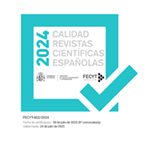Pluralism in Spain’s Digital Terrestrial Television (2010-2013)
Abstract
The introduction of digital terrestrial television (DTT) in Spain in April 2010 was a major change in the state broadcasting system. The aim of this article is to analyze the main consequences that the introduction of DTT has had on external pluralism and the internal pluralism of the news. External pluralism – the plurality of suppliers – was analyzed using three indicators (ownership, market share and advertising revenues) over the period 2010 – 2013. Internal pluralism – diversity reflected in media content – was analyzed using two indicators (crosschannel correlation of newsworthiness and the distribution of subjects across the channels), which were applied to the headline stories in 2012 and 2013. The article discusses the correlation between the two forms of pluralism and reaches the conclusion that external pluralism has no determining influence on internal pluralism during the period covered.Downloads
Article download
License
In order to support the global exchange of knowledge, the journal Estudios sobre el Mensaje Periodístico is allowing unrestricted access to its content as from its publication in this electronic edition, and as such it is an open-access journal. The originals published in this journal are the property of the Complutense University of Madrid and any reproduction thereof in full or in part must cite the source. All content is distributed under a Creative Commons Attribution 4.0 use and distribution licence (CC BY 4.0). This circumstance must be expressly stated in these terms where necessary. You can view the summary and the complete legal text of the licence.










